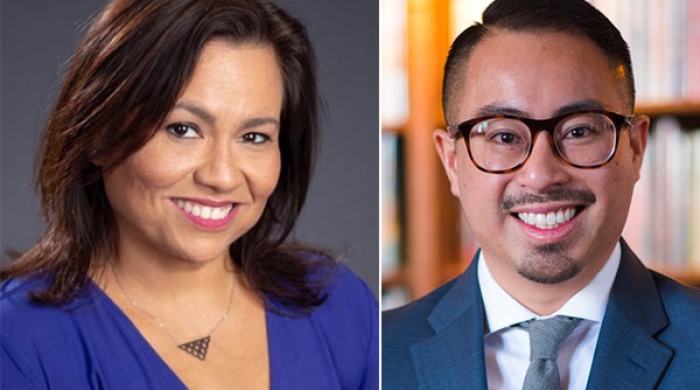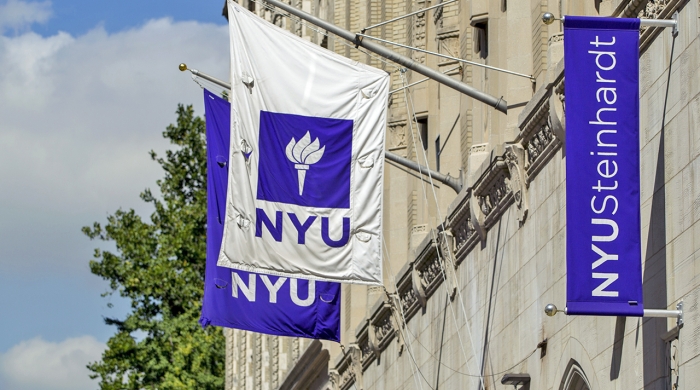NYU Steinhardt education experts warn against an excessively broad interpretation of any decision prohibiting the consideration of an applicant’s race.
As the country awaits the US Supreme Court ruling in the affirmative action cases against the University of North Carolina and Harvard University, experts suggest that the decision will likely significantly impact college admissions. Analysis of the anticipated outcome has also led to broader questions about campus diversity and inclusion efforts, barriers preventing many BIPOC students from attending college, and stereotypes and prejudices that these court cases may perpetuate.

Getty images/skynesher
For insight into the nuances of how the Court’s ruling may impact universities and prospective students, NYU News spoke to NYU Steinhardt professors Mike Hoa Nguyen and Lisa Stulberg. Nguyen co-authored an amicus brief filed on behalf of academics and social scientists in the Students for Fair Admissions v. Harvard case that presented empirical research regarding the educational experiences of Asian American students and called for the use of affirmative action in college admissions to be affirmed. Stulberg has written extensively on affirmative action and race and education, and authored Diversity in American Higher Education: Toward a More Comprehensive Approach (Routledge, 2011). She is currently co-writing (with Anthony S. Chen of Northwestern University) a book outlining the origins and political development of race-conscious affirmative action in college admissions.
What claims do these cases make about Asian American students and other students of color?
Stulberg: The two cases are a bit different here. The case that Students for Fair Admissions, or SFFA, brought against the University of North Carolina does not make any claims about how Asian American students are impacted by UNC’s admissions policies and practices. Only in the Harvard case is there a claim that admissions discriminates against Asian Americans. There are a few important things to keep in mind. First, the claim about Asian Americans in the Harvard case has been made in a top-down way, by SFFA and its president, Ed Blum. There is no individual Asian American plaintiff who has come forward because they feel they were personally discriminated against in the Harvard admissions process. It’s also important to note that the lower court ruling in the Harvard case found no evidence of discrimination against Asian Americans, and the appellate court upheld this ruling.
Nguyen: SFFA, in the Harvard case, makes several claims that leverage harmful racial stereotypes about Asian American students, and in doing so ignores major differences among the diverse and complex educational experiences of Asian Americans. For example, they argue that Asian American students are “substantially stronger” than other demographic groups “on nearly every measure of academic achievement, including SAT scores” and “GPA.” This inaccurate assumption is fundamentally flawed and reinforces the “model minority myth,” where Asian Americans are perceived to be higher achieving and value education more than other racial groups, especially those of minoritized identities. And it is this myth that disregards social, historical, and public policy factors that can drive academic achievement for some Asian Americans, while completely ignoring the educational challenges faced by other Asian Americans, such as Southeast Asian Americans, and for other students of color.
Additionally, some opponents of affirmative action promote an inaccurate notion – that Asian Americans students must score higher than other students to get accepted into a highly selective institution. However, tests like the SAT are imperfect measures of merit, and are often more associated with one’s parental educational attainment levels and socioeconomic status, rather than college success. Yet there is a persistent claim that Asian Americans must score considerably higher on these tests. This claim is based upon a study that uses data that is nearly three decades old and does not account for the many other factors used in college admissions, such as essays and letters of recommendation. In fact, even the study’s lead author, Thomas Espenshade, has cautioned readers to not overinterpret the findings or that it establishes racial bias.
Regardless of the Court’s ruling, colleges and universities must maintain their moral and legal obligations to promote educational equity, access, opportunity, and success for students of color. And in doing so, they must take proactive steps across a wide selection of tools to ensure these outcomes.
How have these cases shaped public opinion of affirmative action? What should the public know?
Stulberg: I’m not sure of the impact of the cases, themselves, on public opinion. But, more broadly, despite the claim by those who oppose race-conscious affirmative action that affirmative action is wildly unpopular, that’s just not true. Recent data are mixed on the extent to which Americans support a small, affirmative consideration of race in admissions. There is some evidence from a 2022 Pew study that the majority of Americans do not favor taking race into consideration in college admissions, though this depends on the way that the question is worded by pollsters. On the other hand, a Gallup Poll conducted in 2021 found that 62 percent of Americans support affirmative action programs. This was the highest level of support since 2001, though it’s not clear from the question whether respondents were considering programs in employment or education. And, most recently, in May 2023, an AP-NORC Center for Public Affairs Research poll found that “most oppose banning the consideration of race and ethnicity in college and university admissions.” The poll found that, when asked directly about the upcoming Supreme Court decision, 63 percent of respondents said that “the Supreme Court should not prohibit the consideration of race and ethnicity in admissions.”
Nguyen: Perhaps this is due to the patchwork of how affirmative action is practiced and not practiced across the country, and how it is legally permissible in some states and banned in others. Additionally, not all polling is created equal. How the question is asked and what context is given greatly impacts how respondents may feel about affirmative action, and shapes their understanding of how affirmative action was historically practiced compared to how it is practiced today, why affirmative action exists and how that has changed over time, and what is legally permissible and how that has changed from Bakke to Fisher. Nonetheless, scholars from AAPI Data found that 69 percent of Asian American voters, when asked in English as well as in their Asian language, supported affirmative action in college admissions.
What are your biggest concerns about a ruling overturning affirmative action in college admissions?
Stulberg: I would say that I have two primary concerns. The first is that colleges and universities are going to go farther than they need to go, legally, to respond to a Supreme Court decision. It’s very important to remember that the Harvard and UNC cases are about the consideration of race in admissions – not in education programming or other efforts related to diversity, equity, inclusion, and belonging on campus. I’m afraid that educational institutions will begin to roll back other programs and initiatives designed to support students and support student diversity, even though the cases are about admissions only, not broadly about whether race can ever be used as a way to organize educational supports or experiences. Secondly, I am quite worried about how a ruling to overturn race-conscious admissions will impact the representation of Black and Latinx students, especially, at selective colleges. The social science evidence – and what we know from the states that have legally had to implement admissions plans that do not consider race – is that there is no race-neutral alternative to race-conscious affirmative action. No supposedly race-neutral or economic-focused policy will produce the same level of racial and ethnic diversity that a positive attention to race does. So, we need to be able to employ race-conscious affirmative action in admissions if we want to benefit from the rich, diverse classroom and campus experiences that so many of us value about higher education.
Nguyen: There is a wide range of potential outcomes that can result from the Court’s decision for both cases. On one end, the Court can uphold Grutter, where race can be used as one of many factors in college admissions. On the other end, it can completely restrict the use of race in admissions. Or the Court can offer one of many different rulings that rests in between these two poles. However, if the Court does rule against 45 years of legal precedent, where the consideration of race in college admissions can no longer be used to build a diverse cohort of students, in which the educational benefits of diversity flow, there will be a devastatingly negative effect in college admissions for students of color, including Asian Americans. Regardless of the Court’s ruling, colleges and universities must maintain their moral and legal obligations to promote educational equity, access, opportunity, and success for students of color. And in doing so, they must take proactive steps across a wide selection of tools to ensure these outcomes.
What factors should universities consider in determining how they respond if affirmative action is affirmed or struck down?
Nguyen: Colleges and universities, irrespective of the Court’s decision, should promote policies and practices that widen educational opportunity and work towards eliminating racial inequality in higher education. This means focusing on initiatives that improve campus racial climate and develop a greater sense of belonging for students of color, through academic, co-curricular, and research opportunities, among many others. These campus-based actions should be designed in a manner that promotes students’ full selves. Additionally, colleges and universities must continue and expand outreach and implement initiatives in and with underserved communities to develop and expand pipelines and preparation for higher education.
Stulberg: As I’ve said, it’s important for colleges and universities to keep in mind that the Harvard and UNC cases are about the consideration of race in admissions only – not in education programming more broadly. I suppose the Supreme Court could go beyond the questions that are before it and issue a very broad ruling here, but the cases that are presented to the Court are about admissions only. So, I hope that higher ed administrators will not take it upon themselves to roll back programming that works to recruit and support students of color on campus. The reality is that affirmative action – taking race into consideration a small amount in admissions – is not going to solve educational injustice and inequality in this country. There are much broader institutional and political educational challenges to racial equity that higher education and its policies can’t solve. But, there are some things that colleges and universities could do to more broadly impact access to educational opportunity, even if they don’t have race-conscious affirmative action as a tool in the near future. To focus broadly on educational access and equity, civil rights and education policy groups have proposed ending early decision practices in admission, ending legacy admission and preference for children of donors, challenging merit aid while providing more need-based aid, going test-free, and eliminating the consideration of AP course-taking in the admissions process. These will not be politically easy changes, but colleges and universities with a commitment to educational equity should consider them.
Related Articles
Affirmative Action Event Highlights Role of Researchers in Informing Education Policy
The event, hosted by the NYU Steinhardt Institute for Higher Education Policy, included remarks by Assistant Professor of Education Mike Hoa Nguyen.
Two NYU Steinhardt Professors Selected as 2022 National Academy of Education/Spencer Postdoctoral Fellows
Professors Alejandro Ganimian and Kongji Qin are among the 25 fellows selected.
BlackCreate Framework: Dr. Lauren Mims Illustrates How Effective Black Creative Educational Experiences Create Space for Creative Expression and Education
In their article, Dr. Lauren Mims, assistant professor of applied psychology, and colleagues illustrate how effective Black creative educational experiences create fugitive spaces for creative expression and education.





